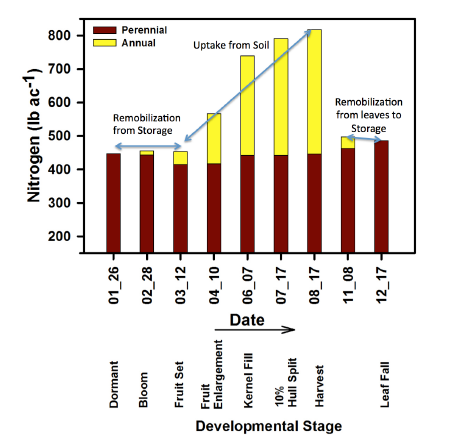There has been a lot of workshops and seminars discussing nitrogen management in almond. The data and conclusions discussed from these trials has been thought provoking, and has provided information to help better manage almond orchard nitrogen. One particular slide has caught my attention – and provides the basis of nitrogen timings for almond orchards.
This figure was developed through whole tree assays. In this study, researchers collected nutrient concentrations from all of the different plant tissues (roots, trunk, branches, leaves, nuts) from mature, field grown almond trees. By viewing the dynamics of nitrogen accumulation, the rate and pattern of nitrogen uptake from the soil can be determined.
From this figure, a few conclusions can be drawn:
- From dormancy through early leaf-out, nitrogen is mobilized from stored reserves and essentially no uptake of N occurs from the soil.
- From leaf to fruit expansion, soil uptake of nitrogen is beginning and nitrogen continues to be mobilized from stored reserves.
- From full leaf expansion through hull-split, nitrogen demand is being met with root uptake. 90% of the tree’s demand for annual nitrogen is during this time.
- Following hull-split, tree nitrogen demand and root uptake decline rapidly, and stop once the leaves begin senescence. Some nitrogen is re-mobilized into perennial storage.
Those conclusions have helped form guidelines for nitrogen applications. Nitrogen should be applied to meet tree’s demand, with 80% of the nitrogen applied from early spring and continuing through hull-split. Fertilization events should be split, with 3-4 applications made through this period with a rate that matches crop load. Timings may be adjusted to prevent hull rot or other issues. The remaining 20% of the nitrogen budget can be applied in the postharvest if an under-estimate of yield occurred. Finally, postharvest applications should only be made if the leaves are healthy and should not exceed 50 pounds of nitrogen.
For more information, please see this excellent article written by Dr. Saa and colleagues. It has also served as the source of information for this article.



C.I.T FOODS – Commodities International Trading – California Almonds: Some Seasonal Perspective On Nitrogen Uptake
March 8, 2014[…] Owen Taylor There has been a lot of workshops and seminars discussing nitrogen management in almond. One […]
Alan McDonald
March 30, 2014Whilst I am in Portugal and a long way from California, I expect the N uptake of trees is similar..
I have read all the Almond Doctor posts relating to N fertilisation and note the 1oz/per application a year rule as well as suggested total rates for young trees that indicates about 8ozs N per year of establishment, ie 3rd leaf 24ozs. Then the amounts in mature orchards of circa 68lbs N per 1000lbs of kernels.
If a 4th leaf takes 32 ozs and 110 trees/acre then that is 220lbs N/acre, and presumably more in the next couple of years, but 68lbs per 1000lbs of kernels per acre in a mature orchard producing 3000lbs/acre is just 204lbs (Dr Saa’s figure) with no allowance for the 20-40lbs needed for new growth.
I would appreciate your comments, with an indication of the maximum amount that should be applied to growing trees not under any stress.
David Doll
April 3, 2014Alan,
I think there is some confusion on the rates for young trees. In a study posted on the website, we found somewhere between 3-4 ounces of actual nitrogen delivered to first leaf trees was enough to maximize growth. These applications were split over 6 timings (1/2 or 2/3rds of an ounce) with no more than one full ounce of nitrogen being delivered at one time. I think the 8 ounces per year is being confused with the amount of a blended fertilizer that it takes to total an ounce of actual N. For example, if the blend has 12% nitrogen, it would take about 8 ozs of fertilizer for one total ounce of actual nitrogen.
This study was supported by estimates from whole tree analysis. In this case, it was determined that developing orchards will need about 25-30 pounds of nitrogen per acre per year. Once trees hit maximum size, this amount is no longer needed. Calculations provided on crop removal account for this requirement if crop yield is over 2000 pounds. If the trees are yielding under 2000 lbs/acre, another 20 pounds of nitrogen are needed for growth. Basically, it is assumed if the trees are yielding under 2000 pounds, they will continue to grow, and thus need the 20 pounds of nitrogen.
4th leaf trees will probably need around 30 pounds for growth and whatever nitrogen is needed to match crop load.
Alan McDonald
April 4, 2014Thank you for your response and clarification. I understand percentages of nutrients in agricultural fertilisers. I overestimated the number of applications that would be made in the growing season as 8 at the one ounce a year rule.
I note that 4th leaf need very little more N than 1st leaf (assuming 110-120 trees/acre) for growth, so presumably that rate is sufficient for all young growing trees.
David Doll
April 5, 2014Based on our best estimates and some field trials, that appears correct – the nutrient needs of non-bearing trees is similar (~25-35 lbs/year).
Hope all is well,
David
2014 Top Ten Articles - The Almond Doctor
December 31, 2015[…] Almond Nitrogen Uptake: Seasonal Perspective. An overview of the uptake pattern of nitrogen and how it is applied to fertilization […]